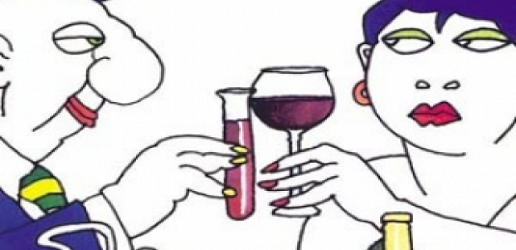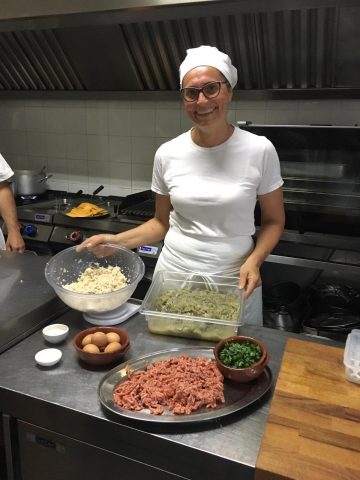Frog’s Blood

Wine terminology is one of the most difficult aspects for those who are moving the first step towards becoming a wine connoisseurter and can lead to even comic situations.
''Frog's blood - Gino said – 'this wine is the color of frog's blood''. Gino was Luigi Veronelli, the great wine and food expert and wonderful writer, and the wine with such a eerie color was a Costozza Rosato from Conte Alvise da Schio. For me it was an antique pink, perhaps a little more orange than normal, and it reminded me, in a more irreverent way, of the Crodino aperitif drink I used to love. But whatever Gino, who at the time had literally adopted me, said was gospel. He was the master and I his pupil. Gino was a very good teacher even if he was not deliberate about it. He was an endless source of anecdotes and 'suggestions', as he used to call them, which for those like me who, with pure passion, were taking their first steps in the world of wine and food were truly fascinating.
Wine terminology is very difficult to master. As in every technical sector it is important to use the right words which, in most cases, are rooted in sciences like botany, organic chemistry and biology as well as other specific ones like ampelography, the description and identification of grape vines. While this scientific aspect is an essential part of the curriculum to become an enologist or wine-making expert, it goes hand-in-hand, sometimes in curious ways, with terms that have more to do with wine's the literary and humanistic side. This because a purely technical, quantitative description needs to be accompanied by one that involves the sensations one experiences when tasting and drinking a wine. And this is where the worse solipsistic bullshit can translate into the most improbable explanations of scents and flavors that only a few could ever relate to much less understand.
The first step towards becoming a wine connoisseur, for some the point of no return, is to take the right courses. Those in Italy are for the most part organized by the Associazione Italiana Sommeliers (AIS) or by Slow Food and to an outsider may at first seem to be some kind of pagan rite. And this may very well be true when it comes to the technique of how to swirl wine in a glass, which in reality is often useless or excessive, or how to hold a glass to a light to better ascertain the color of the wine. Over the years I have learned that by exhaling gently through the nose into the liquid and then inhaling quickly afterward you obtain a much better idea of what the scents are than by swirling. Furthermore, the contrast of a wine against a white tablecloth gives you a much more precise indication of its color that any other flashy technique. But then the way I do it is no good if you want to show off your expertise in the juice of Bacchus.
There are many reasons why people sign up to take wine appreciation courses. Some people do it to be the opinion leader in their group. Others just to have a hobby. And then there are those who after the break-up of a marriage or long relationship are looking for a way to meet new people. The people in this latter group are the most predictable and usually the most fun to be with, as long as they don't get too serious, while those in the first group may have some maniacal tendencies and thus risk being the most dangerous.
Despite all this one cannot deny that these courses have been and remain very popular, sometimes even trendy, and have contributed to increasing the culture of wine. But then obtaining a driver's license does not mean you can race in Formula One. For sure the best thing to do is learn the technical terminology without falling into the trap of using 'wine slang' and rhetoric which is for the most part all invented and inappropriate but is widespread in the world of wine and food. This includes expressions like 'tertiary development of the aroma', 'vertical acidic spine', and 'upheld by the fruit'. What these expressions really means is, respectively, that aging determines the scents, the acidity makes the wine a little prickly and the aroma has not evolved properly and remains centered on fresh fruit and is young and a little commonplace'. But it does not end there. To define a wine as 'vinous' or 'winy' seems like a joke. The term is meant to indicate certain scents typical of young red wines that derive from succinic acid or succinic acid esters to be more precise. But this has to do with organic chemistry and 'vinous' is the term used in sommelier 'speak'. There are a lot of similar examples and if connoisseurs and wine lovers are unable to take them with a grain of salt they could go crazy.
And then there are the telltale, defining scents, those of certain flowers, fruits, particular substances, odorous and aromatic, that should help to describe the salient characteristics of a wine. Sometimes the descriptions are hilarious, others quite disturbing. I once heard the aroma of a harmless Pigato di Albenga as having the scent of 'burned elastic' and I must admit I had a hard time imagining what a similar disaster would smell like. What that wine did have were some smoked scents, determined by the short time it had aged in the bottle, aging that takes place in the almost total absence of oxygen, thus the product of reduction (the opposite of oxidation). A normal person would have said the wine tasted a little 'closed', something that with a little breathing in the glass would go away. A far cry from 'burned elastic'. Just imagine the horror if one were to describe the bouquet of an aged red as 'a basket of dead fowl'. This is, in fact, one of the favorite expressions of a well-known Tuscan taster who has a clear macabre sense of humor. Then there are those fun expressions like 'wooden trunk' or 'cigar box' used to describe the odor of a red wine aged in barriques or 'cat piss' for certain wild scents of a Sauvignon. Someone who does not know a lot about wine could be taken aback if he is invited to a dinner where 'experts' celebrate that certain particular feline characteristic of the wine he has been drinking.
And so we come back to where we started, to frog's blood, a term we must live with for now. This may be the beginning of a particular phenomenology of the spirit. Perhaps, with apologies to Georg Friederich Hegel, it really is.

 Italiano
Italiano








